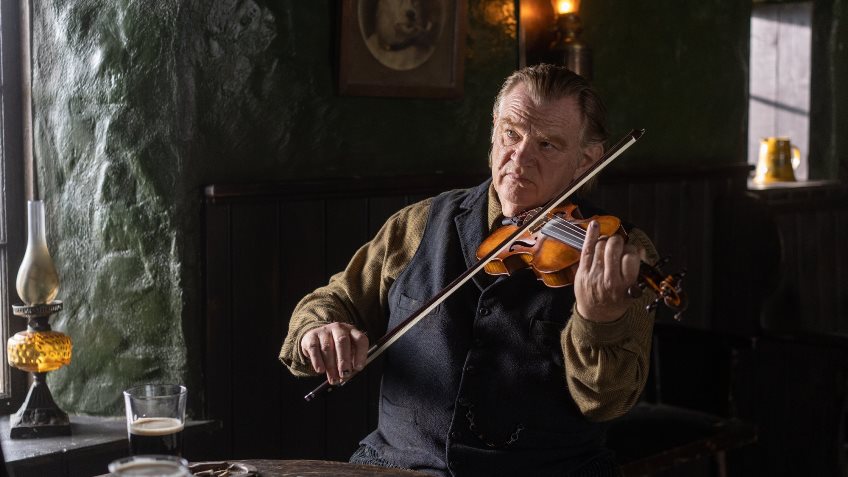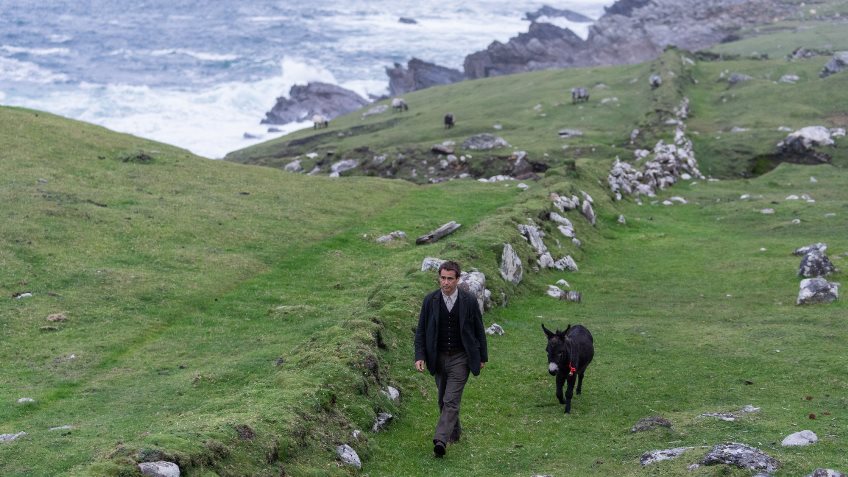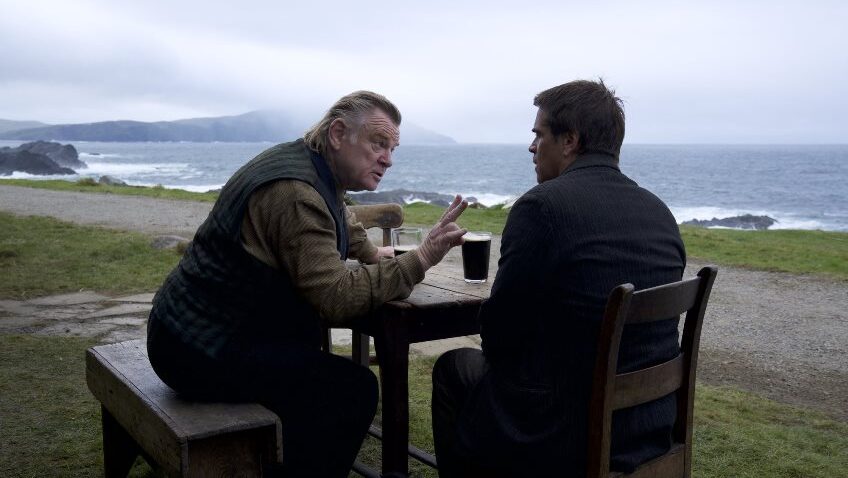Joyce Glaser reviews The Banshees of Inisherin (October 21, 2022) Cert 15,
In the opening ten minutes of The Banshees of Inisherin Pádraic (Colin Farrell) comes to the realisation that his older friend and drinking buddy for years, Colm (Brendan Gleeson) has ditched him. Islanders who are used to seeing the pair together ask Pádraic if they’ve been rowing again, suggesting their relationship, based on their ritualistic 2PM drink at the pub was not always serene. Then Colm tells him directly: ‘I just don’t like you no more.’ Pádraic, stunned, denies it: ‘But you do like me.’ As we shall we, “like” is not the right word, and proves a fatal choice.
Colm, a fiddler, aware of his impending mortality is determined to make his remaining years matter. He considers Pádraic dull, a waste of time, and wants to focus on composing music and interacting with fellow musicians who gravitate to the island. Pádraic’s refusal to accept Colm’s rejection drives the plot, is the plot, and facilitates the work of the Banshees, paving the way from dark comedy to tragedy.
Colm, in his late sixties, lives alone with his fiddle and his beloved dog in a drystone walled house by the sea. Pádraic is a small time dairy farmer, who lives nearby in a stark, two-room drystone walled house with his compassionate, but no-nonsense sister Siobhán (Kerry Condon, perfect), and, when Siobhán is not around to protest, his beloved miniature donkey, Jenny.

No one but the pub landlord (Pat Short), a gossipy shopkeeper and the nasty local policeman, Peadar Kearney (Gary Lydon) seem to earn a living. But in 1923 on the island there’s not much to spend money on outside of stout. Most women make their family’s clothes which might account for the thick, quality wool clothing.
Pádraic and Siobhán sleep in the same twin-bedded room, which is rendered less cringe-inducing when you hear Siobhán speak. She’s the island’s intellectual, always immersed in books and curious about the outside world, the opposite of her younger brother who, on the hierarchy of intelligence, is just above Officer Kearney’s abused son, Dominic (Barry Keoghan) the so-called village idiot.
Anyone who saw Keoghan’s spine-tingling performance in the 2017, The Killing of a Sacred Deer will never forget it. He is equally good here in type casting. Dominic, who acts as Pádraic’s sounding board when Colm breaks off their friendship, is glad to have inherited a friend. He may be the village idiot, but he is the only character in the film who speaks of love and has the good taste to dream above his station of marrying Siobhán. But Siobhán, unlike her stubborn brother, has bigger plans.
Despite his sister’s urgent appeals, and the prophesies of Mrs McCormick (Sheila Flitton), a pipe-smoking old lady in 19th century attire, who pops up on the roadside or, to his annoyance, in Pádraic’s home, where Siobhán feels obliged to give her tea, Pádraic cannot accept Colm’s decree. He tries every trick in the book to talk to Colm. So Colm ups the ante and tells Pádraic that if he approaches him again or knocks on his door, he will cut off his fingers on his fiddle playing hand, one by one.
In most films, novels or plays, the end of a friendship or any relationship occurs at the end or the halfway point, and the work traces the deterioration of the relationship at least in flashback. But The Banshees of Inisherin is not any film. It is the third written and directed by Martin McDonagh, following his cult hit In Bruges, and his Academy Award showered Three Billboards Outside Ebbing Missouri.
And it follows his plays, The Beauty Queen of Leenane (1996), The Cripple of Inishmaan (1996), The Lieutenant of Inishmore (2001) and A Behanding in Spokane (2010). Specific place names unite this selection of his (best) work. The setting of McDonagh’s latest film, however, is more than fictitious: it is metaphorical. Inisherin means Island/Ireland, or the Island of Ireland. Audiences will make of that what they will but are aided with occasional references here to the sounds of guns and bombs on the mainland. It is 1923 at the beginning of the conflict of Northern Ireland.
In addition to McDonagh’s trademark style of violence mixed with quirky humour, and characters as remote from the intelligentsia or urban, educated middle classes as you can get, The Banshees of Inisherin is familiar in other ways. It has a lot in common with In Bruges, including the repairing of Colin Farrell and Brendan Gleeson as chalk and cheese buddies, and with Three Billboards in the mix of comedy and violence and the steely determination of the central characters (echoed in Colm’s determination to break with Pádraic and Pádraic’s resolve to defeat that decision).

But it is most directly related to McDonagh’s 1993 play, The Lieutenant of Inishmore, set in the year of the Bishopsgate Bombing, in the last violent attempts of the IRA to influence the imminent ceasefire. Pádraic of Inisherin is the non-political, seemingly non-violent namesake of Mad Pádraic a Lieutenant in the Irish National Liberation Army in Belfast, considered too mad for the IRA. When he hears that his cat, Wee Thomas, is ill, Pádraic races home to Inishmore where his search for We Thomas triggers a farcical killing spree. The adorable donkey, Jenny, is here for a reason.
Around halfway through The Banshees of Inisherin Officer Kearney, comments on the source of the noise that others only acknowledge, if that. Perhaps speaking metaphorically, Colm says he believes they are coming to the end of the conflict, but Pádraic believes it will flare up again. Explaining the purpose of his mission to the mainland, Kearney says that ‘The Free State lads are executing a couple of the IRA lads… and then pauses to consider if it isn’t the other way around. ‘It was so much easier when we were all the same side and only the English were on the other side.’
It seems that McDonagh wants us to equate the Colm – Pádraic dispute that spirals out of control to the larger sphere and the Conflict in Northern Island that lasted nearly a century if not longer, with plenty of torture, mutilation and former friends turning enemies. All conflict is free game for comedy but whether this comedy grows repetitive and whether the equation hits home, might depend on your point of view.
What is beyond dispute is the entertainment value of the four leads, and particularly Kerry Condon, who co-starred in the first production of The Lieutenant of Inisherin in 2001 when she was 18. Farrell stands out as Pádraic, shocked at the realisation that he is dull, but bolstered by Dominic’s view that he is not so much dull as nice. Only the Banshee disappoints, as oddly, Flitton’s Mrs McCormick, the titular character straight out of Irish folklore, falls below the radar.




